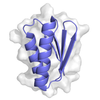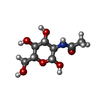+ Open data
Open data
- Basic information
Basic information
| Entry | Database: PDB / ID: 9n5y | ||||||
|---|---|---|---|---|---|---|---|
| Title | Hemagglutinin CA09 homotrimer bound to AEL31302/AEL31311 Fab | ||||||
 Components Components |
| ||||||
 Keywords Keywords | IMMUNE SYSTEM/VIRAL PROTEIN / antibody-antigen complex / hemagglutinin / IMMUNE SYSTEM-VIRAL PROTEIN complex | ||||||
| Function / homology |  Function and homology information Function and homology informationviral budding from plasma membrane / clathrin-dependent endocytosis of virus by host cell / host cell surface receptor binding / fusion of virus membrane with host plasma membrane / fusion of virus membrane with host endosome membrane / viral envelope / virion attachment to host cell / host cell plasma membrane / virion membrane / membrane Similarity search - Function | ||||||
| Biological species |  Homo sapiens (human) Homo sapiens (human)  Influenza A virus Influenza A virus | ||||||
| Method | ELECTRON MICROSCOPY / single particle reconstruction / cryo EM / Resolution: 4.1 Å | ||||||
 Authors Authors | Fernandez-Quintero, M.L. / Turner, H.L. | ||||||
| Funding support | 1items
| ||||||
 Citation Citation |  Journal: Nat Mach Intell / Year: 2025 Journal: Nat Mach Intell / Year: 2025Title: Predicting the conformational flexibility of antibody and T cell receptor complementarity-determining regions. Authors: Fabian C Spoendlin / Monica L Fernández-Quintero / Sai S R Raghavan / Hannah L Turner / Anant Gharpure / Johannes R Loeffler / Wing K Wong / Alexander Bujotzek / Guy Georges / Andrew B Ward ...Authors: Fabian C Spoendlin / Monica L Fernández-Quintero / Sai S R Raghavan / Hannah L Turner / Anant Gharpure / Johannes R Loeffler / Wing K Wong / Alexander Bujotzek / Guy Georges / Andrew B Ward / Charlotte M Deane /    Abstract: Many proteins are highly flexible and their ability to adapt their shape can be fundamental to their functional properties. For example, the flexibility of antibody complementarity-determining region ...Many proteins are highly flexible and their ability to adapt their shape can be fundamental to their functional properties. For example, the flexibility of antibody complementarity-determining region (CDR) loops influences binding affinity and specificity, making it a key factor in understanding and designing antigen interactions. With methods such as AlphaFold, it is possible to computationally predict a single, static protein structure with high accuracy. However, the reliable prediction of structural flexibility has not yet been achieved. A major factor limiting such predictions is the scarcity of suitable training data. Here we focus on predicting the structural flexibility of functionally important antibody and T cell receptor CDR3 loops. To this end, we constructed ALL-conformations by extracting CDR3s and CDR3-like loop motifs from all structures deposited in the Protein Data Bank. This dataset comprises 1.2 million loop structures representing more than 100,000 unique sequences and captures all experimentally observed conformations of these motifs. Using this dataset, we develop ITsFlexible, a deep learning tool with graph neural network architecture. We trained the model to binary classify CDR loops as 'rigid' or 'flexible' from inputs of antibody structures. ITsFlexible outperforms all alternative approaches on our crystal structure datasets and successfully generalizes to molecular dynamics simulations. We also used ITsFlexible to predict the flexibility of three CDRH3 loops with no solved structures and experimentally determined their conformations using cryogenic electron microscopy. | ||||||
| History |
|
- Structure visualization
Structure visualization
| Structure viewer | Molecule:  Molmil Molmil Jmol/JSmol Jmol/JSmol |
|---|
- Downloads & links
Downloads & links
- Download
Download
| PDBx/mmCIF format |  9n5y.cif.gz 9n5y.cif.gz | 438.6 KB | Display |  PDBx/mmCIF format PDBx/mmCIF format |
|---|---|---|---|---|
| PDB format |  pdb9n5y.ent.gz pdb9n5y.ent.gz | 331.8 KB | Display |  PDB format PDB format |
| PDBx/mmJSON format |  9n5y.json.gz 9n5y.json.gz | Tree view |  PDBx/mmJSON format PDBx/mmJSON format | |
| Others |  Other downloads Other downloads |
-Validation report
| Summary document |  9n5y_validation.pdf.gz 9n5y_validation.pdf.gz | 1.7 MB | Display |  wwPDB validaton report wwPDB validaton report |
|---|---|---|---|---|
| Full document |  9n5y_full_validation.pdf.gz 9n5y_full_validation.pdf.gz | 1.7 MB | Display | |
| Data in XML |  9n5y_validation.xml.gz 9n5y_validation.xml.gz | 74 KB | Display | |
| Data in CIF |  9n5y_validation.cif.gz 9n5y_validation.cif.gz | 107.4 KB | Display | |
| Arichive directory |  https://data.pdbj.org/pub/pdb/validation_reports/n5/9n5y https://data.pdbj.org/pub/pdb/validation_reports/n5/9n5y ftp://data.pdbj.org/pub/pdb/validation_reports/n5/9n5y ftp://data.pdbj.org/pub/pdb/validation_reports/n5/9n5y | HTTPS FTP |
-Related structure data
| Related structure data |  49043  9n5zC M: map data used to model this data C: citing same article ( |
|---|---|
| Similar structure data | Similarity search - Function & homology  F&H Search F&H Search |
- Links
Links
- Assembly
Assembly
| Deposited unit | 
|
|---|---|
| 1 |
|
- Components
Components
| #1: Antibody | Mass: 25910.879 Da / Num. of mol.: 3 Source method: isolated from a genetically manipulated source Source: (gene. exp.)  Homo sapiens (human) / Production host: Homo sapiens (human) / Production host:  #2: Antibody | Mass: 27024.441 Da / Num. of mol.: 3 Source method: isolated from a genetically manipulated source Source: (gene. exp.)  Homo sapiens (human) / Production host: Homo sapiens (human) / Production host:  #3: Protein | Mass: 62401.727 Da / Num. of mol.: 6 Source method: isolated from a genetically manipulated source Source: (gene. exp.)  Influenza A virus (A/California/01/2009(H1N1)) Influenza A virus (A/California/01/2009(H1N1))Gene: HA / Production host:  Homo sapiens (human) / Strain (production host): ExpiHEK293F / References: UniProt: A0A3S7XTA4 Homo sapiens (human) / Strain (production host): ExpiHEK293F / References: UniProt: A0A3S7XTA4#4: Polysaccharide | Source method: isolated from a genetically manipulated source #5: Sugar | ChemComp-NAG / Has ligand of interest | N | Has protein modification | Y | |
|---|
-Experimental details
-Experiment
| Experiment | Method: ELECTRON MICROSCOPY |
|---|---|
| EM experiment | Aggregation state: PARTICLE / 3D reconstruction method: single particle reconstruction |
- Sample preparation
Sample preparation
| Component | Name: Hemaggluinin CA09 homotrimer bound to AEL31302/AEL31311 mAb Type: COMPLEX / Entity ID: #1-#3 / Source: RECOMBINANT |
|---|---|
| Molecular weight | Value: 0.330 MDa / Experimental value: NO |
| Source (natural) | Organism:  Homo sapiens (human) Homo sapiens (human) |
| Source (recombinant) | Organism:  Homo sapiens (human) Homo sapiens (human) |
| Buffer solution | pH: 7.4 / Details: TBS |
| Specimen | Conc.: 1.14 mg/ml / Embedding applied: NO / Shadowing applied: NO / Staining applied: NO / Vitrification applied: YES |
| Specimen support | Grid material: GOLD / Grid mesh size: 300 divisions/in. / Grid type: Quantifoil R1.2/1.3 |
| Vitrification | Instrument: FEI VITROBOT MARK IV / Cryogen name: ETHANE / Humidity: 100 % / Chamber temperature: 277 K |
- Electron microscopy imaging
Electron microscopy imaging
| Microscopy | Model: TFS GLACIOS |
|---|---|
| Electron gun | Electron source:  FIELD EMISSION GUN / Accelerating voltage: 200 kV / Illumination mode: FLOOD BEAM FIELD EMISSION GUN / Accelerating voltage: 200 kV / Illumination mode: FLOOD BEAM |
| Electron lens | Mode: BRIGHT FIELD / Nominal magnification: 190000 X / Nominal defocus max: 1600 nm / Nominal defocus min: 800 nm / Cs: 2.7 mm / C2 aperture diameter: 50 µm / Alignment procedure: COMA FREE |
| Specimen holder | Cryogen: NITROGEN / Specimen holder model: FEI TITAN KRIOS AUTOGRID HOLDER |
| Image recording | Electron dose: 45 e/Å2 / Film or detector model: FEI FALCON IV (4k x 4k) |
- Processing
Processing
| EM software |
| ||||||||||||||||||||||||
|---|---|---|---|---|---|---|---|---|---|---|---|---|---|---|---|---|---|---|---|---|---|---|---|---|---|
| CTF correction | Type: NONE | ||||||||||||||||||||||||
| 3D reconstruction | Resolution: 4.1 Å / Resolution method: FSC 0.143 CUT-OFF / Num. of particles: 85692 / Symmetry type: POINT | ||||||||||||||||||||||||
| Refinement | Highest resolution: 4.1 Å Stereochemistry target values: REAL-SPACE (WEIGHTED MAP SUM AT ATOM CENTERS) | ||||||||||||||||||||||||
| Refine LS restraints |
|
 Movie
Movie Controller
Controller




 PDBj
PDBj









